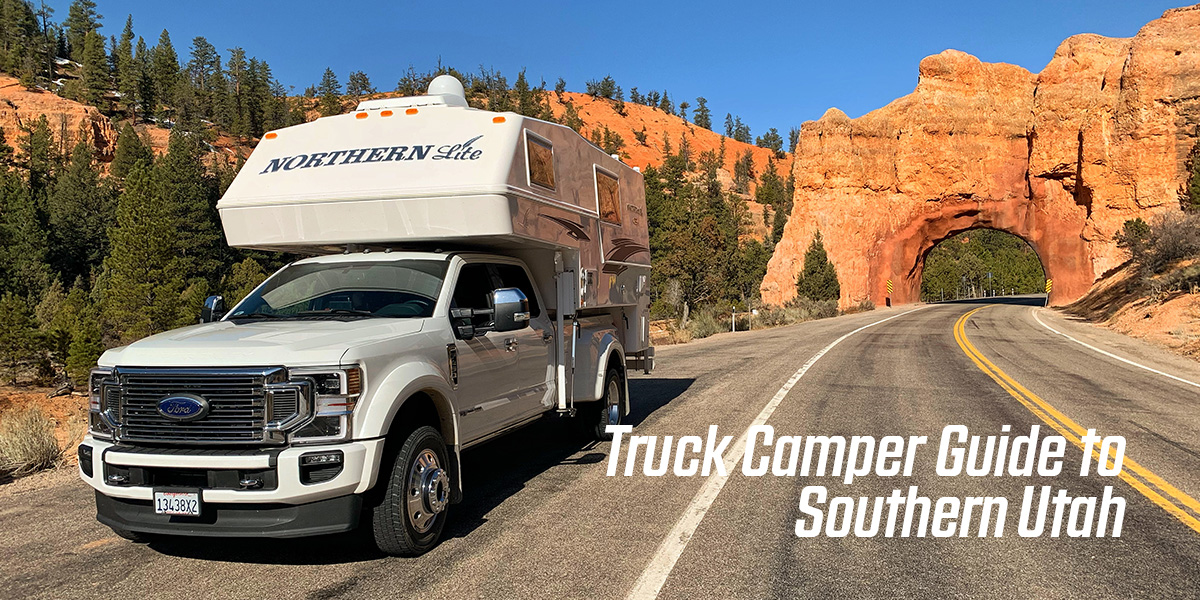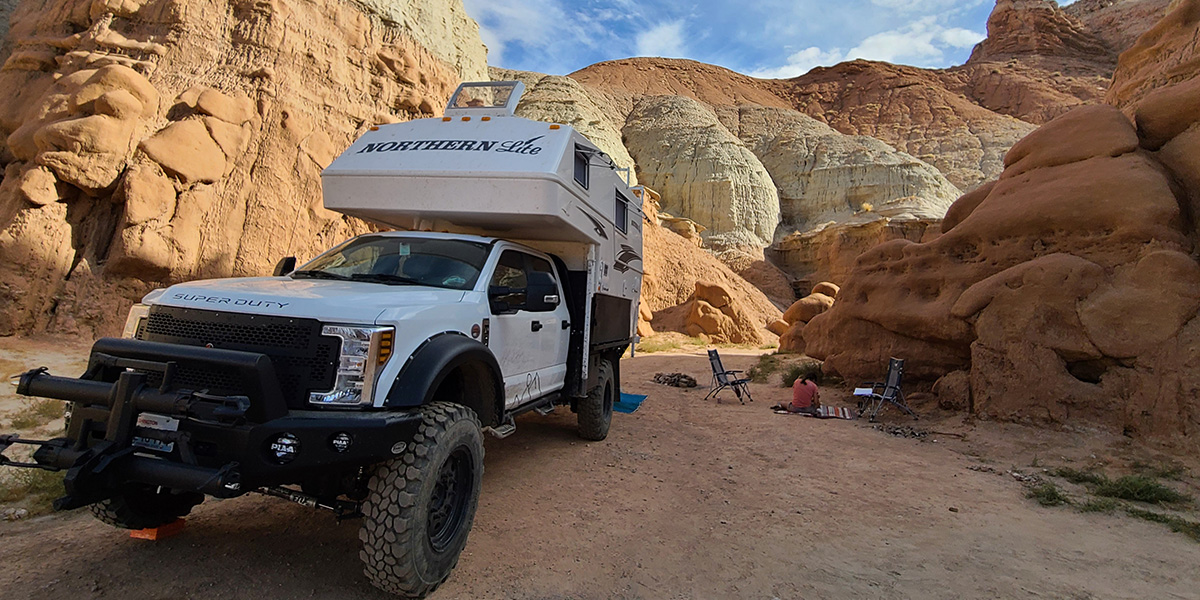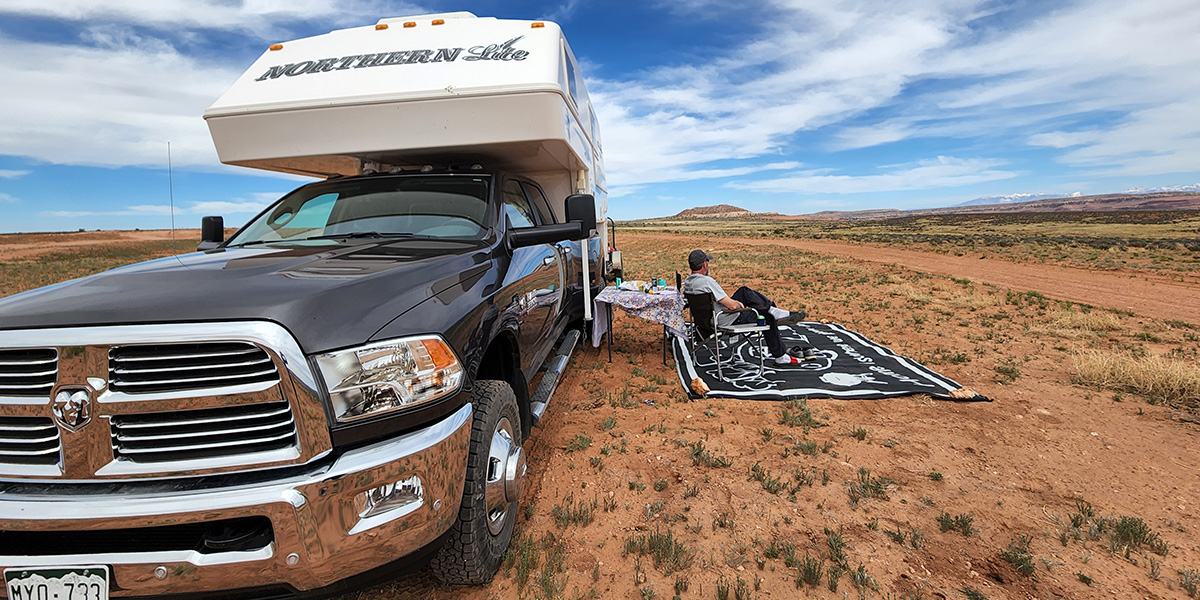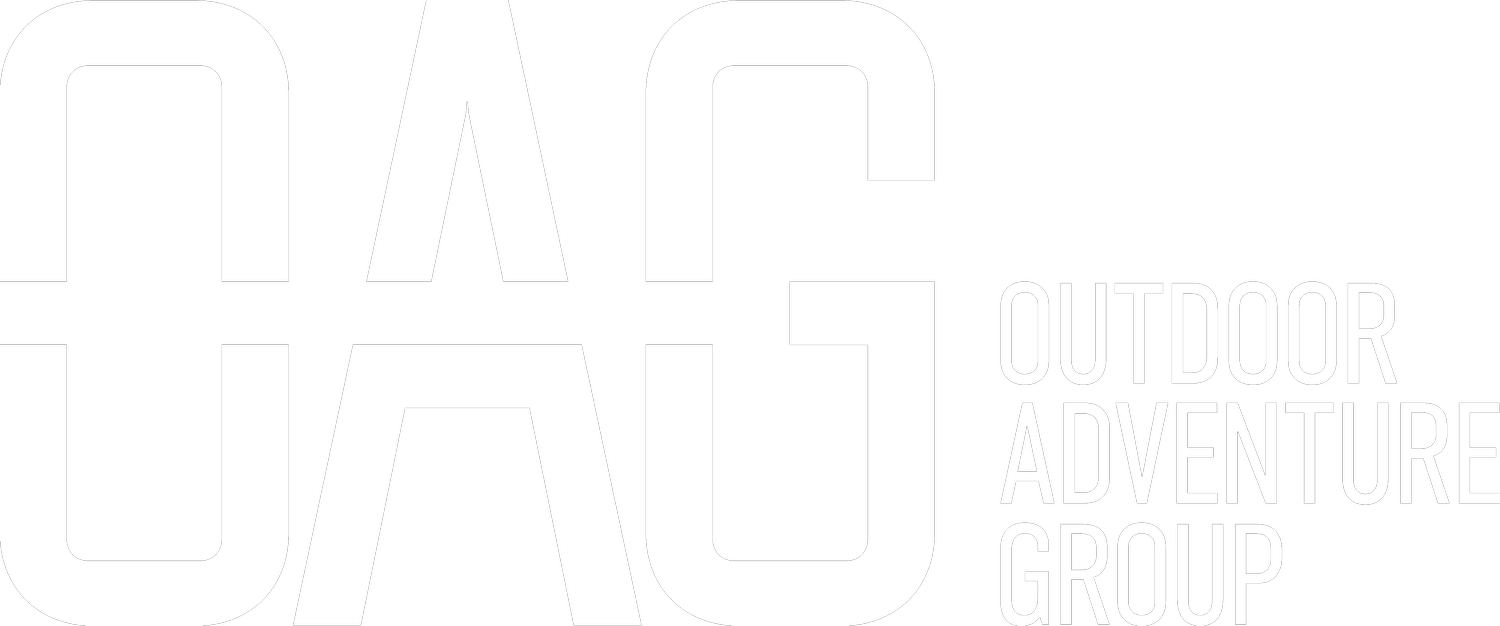
Photo: Richard Balch
Truck Camper Guide to Southern Utah - Explore Moab, Canyonlands, Bryce Canyon, and Arches National Park
With its stunning red rock formations, rugged terrain, and abundance of outdoor activities, southern Utah is a bucket list destination for many Northern Lite truck camper owners.
The small town of Moab provides a great base to explore southern Utah’s several stunning National Parks including Arches National Park, Canyonlands, and Bryce Canyon National Park. Along with all of the conveniences that you need such as restaurants and grocery stores, Moab has several guide operations to help you experience a range of adventures from mountain biking to 4-wheel drive excursions.
Getting There
Moab is located in southeastern Utah, approximately 3.5 hours’ drive from Salt Lake City, UT, and 4.5 hours from Denver, CO. The best way to get there is via Interstate 70, which offers scenic views of the surrounding landscape.
Activities
Off-Roading: Moab is known for its challenging off-road trails, which are popular with Jeep and ATV enthusiasts. Some popular trails include the Hell’s Revenge Trail, the Fins and Things Trail, and the Poison Spider Mesa Trail.
Mountain Biking: Moab has over 100 miles of mountain biking trails, ranging from easy to extremely difficult. Some popular trails include the Slickrock Trail, the Porcupine Rim Trail, and the Amasa Back Trail.
River Rafting: The Colorado River runs through Moab, offering scenic rafting trips through the surrounding canyons. Trips range from half-day to multi-day excursions.
Arches National Park
Arches National Park is a must-see destination for anyone who loves natural beauty and outdoor adventure. Whether you’re an experienced traveler or just starting out, exploring Arches National Park in a truck camper can be an unforgettable experience. Here’s a guide to help you make the most of your trip.
Getting There
Arches National Park is located in eastern Utah, about 5 miles north of Moab. If you’re traveling in a truck camper, you’ll want to take Interstate 70 and exit at US-191 south, which will take you directly to the park.
Camping
There are two campgrounds in Arches National Park: Devils Garden Campground and Willow Flat Campground. Devils Garden is the larger of the two and offers more amenities, including flush toilets, potable water, and RV hookups. Willow Flat is smaller and more primitive, with no RV hookups and pit toilets only. Both campgrounds have a 14-day limit on camping and operate on a first-come, first-served basis.
If you prefer a more secluded camping experience, there are also several BLM (Bureau of Land Management) campgrounds nearby. These campgrounds are free and offer more privacy, but have fewer amenities.
Exploring the Park
Arches National Park is known for its stunning natural arches, rock formations, and hiking trails. Some of the must-see attractions include:
- Delicate Arch: This is the most famous arch in the park and can be seen from a viewpoint or hiked to from a trailhead. The hike is about 3 miles round-trip and can be strenuous, but the views of the arch and surrounding landscape are well worth it.
- Landscape Arch: This is the largest arch in the park and one of the longest natural arches in the world. The trail to Landscape Arch is an easy 1.6-mile round-trip hike.
- Fiery Furnace: This is a labyrinth of narrow canyons and towering rock formations that can only be explored with a permit or ranger-led tour. The tour is 2.5 hours long and requires good physical fitness and balance.
- Balanced Rock: This is one of the most iconic formations in the park and can be seen from the road or hiked to from a nearby trailhead.
- Double Arch: This is a unique formation where two arches intersect and create a stunning double arch. The trail to Double Arch is an easy half-mile round-trip hike.
Other Activities
Aside from hiking and sightseeing, there are several other activities to enjoy in Arches National Park. These include:
- Stargazing: The park has some of the darkest skies in the country and is a great place to see stars and constellations.
- Scenic Drives: There are several scenic drives in the park that offer stunning views of the landscape. The most popular drive is the 18-mile Arches Scenic Drive, which takes you through the heart of the park.
- Photography: Arches National Park is a photographer’s paradise, with endless opportunities to capture stunning landscapes and rock formations.
- Rock Climbing: For experienced climbers, Arches National Park offers some of the most challenging and rewarding climbs in the country.

Photo: Corey Hoffman
Canyonlands National Park
Canyonlands National Park is a beautiful and vast wilderness area located in southeastern Utah. With stunning landscapes, a rich history, and endless opportunities for outdoor adventure, exploring Canyonlands National Park in a truck camper is an unforgettable experience.
Getting There
Canyonlands National Park is located near Moab, and is about a 30-minute drive from Arches National Park. If you’re traveling in a truck camper, you can take Highway 191 south from Moab to access the park.
Camping and Exploring the Park
Canyonlands National Park is a vast and rugged wilderness area with
diverse landscapes and countless opportunities for outdoor adventure. There are several campgrounds in Canyonlands National Park, ranging from primitive sites to those with more amenities. The park’s campgrounds are located in different districts, so you’ll want to choose one based on the area you plan to explore.
-
Island in the Sky: This is the most accessible and popular district of the park, with two campgrounds to choose from. Willow Flat Campground is located near the visitor center and has pit toilets, but no RV hookups. Needles Outpost Campground is located further south and has more amenities, including flush toilets and showers. This district of the park offers stunning views of the surrounding
canyons and the Colorado and Green Rivers. Highlights include Mesa Arch,
Grand View Point, and Upheaval Dome. -
The Needles: This district is located south of Island in the Sky and is known for its unique rock formations and hiking trails. There are two campgrounds in this area: Squaw Flat Campground and Devil’s Kitchen Campground. Squaw Flat has more amenities, including flush toilets and RV hookups, while Devil’s Kitchen is more primitive with pit toilets only. This district of the park is known for its unique rock formations,
including towering spires and arches. Highlights include the Chesler
Park Loop Trail, Elephant Hill, and Slickrock Foot Trail. -
The Maze: This district is the most remote and least visited of the park, and is only accessible by 4-wheel drive vehicles or on foot. There are no designated campgrounds in this area, so camping is only allowed in designated areas with a permit. This district of the park is known for its unique rock formations, including towering spires and arches. Highlights include the Chesler Park Loop Trail, Elephant Hill, and Slickrock Foot Trail.

Photo: Julianne Bacialli
Bryce Canyon National Park
Bryce Canyon National Park is a stunningly beautiful natural area located in southern Utah. With its unique geological formations, abundant wildlife, and diverse outdoor recreation opportunities, exploring Bryce Canyon in a truck camper is a must-do experience. Here’s a guide to help you plan your trip.
Getting There
Bryce Canyon National Park is located in southern Utah, approximately 4 hours’ drive from Salt Lake City, UT, and 2.5 hours from Las Vegas, NV. If you’re traveling in a truck camper, the best route to take is via Utah State Route 12, which offers incredible views of the surrounding landscape.
Camping
There are two campgrounds within the park: North Campground and Sunset Campground. Both campgrounds have RV sites with electrical hookups, water, and sewer, as well as restrooms and showers. Reservations are recommended, especially during the peak season from May to September.
There are also several private campgrounds located outside the park, in the nearby town of Bryce Canyon City. These campgrounds offer a range of amenities, including Wi-Fi, laundry facilities, and swimming pools.
Exploring the Park
Bryce Canyon National Park is known for its unique geological formations called hoodoos, which are tall, thin spires of rock that have been eroded over time. The park offers several ways to explore these formations and the surrounding landscape:
-
Scenic Drives: The park has two main scenic drives, Bryce Canyon Scenic Drive and Rainbow Point Road, which offer breathtaking views of the park’s hoodoos and other rock formations. Both drives are open year-round, weather permitting.
-
Hiking: Bryce Canyon has over 50 miles of hiking trails, ranging from easy strolls to strenuous backcountry hikes. Some of the most popular trails include the Navajo Loop Trail, Queens Garden Trail, and Fairyland Loop Trail.
-
Horseback Riding: The park offers guided horseback rides through the Bryce Canyon landscape. Rides are available from April to October and can be booked at the park’s visitor center.
-
Astronomy Programs: Bryce Canyon has some of the clearest and darkest skies in the country, making it a great place for stargazing. The park offers ranger-led astronomy programs, including telescope viewing and multimedia presentations.
Safety Tips
When exploring southern Utah in a truck camper, it’s important to follow these safety tips:
Be aware of the high elevation and dry climate, which can cause dehydration and other health issues.
Carry plenty of water, snacks, and sunscreen.
Stay on designated roads and trails.
Check the weather forecast before heading out and be prepared for sudden changes.
Follow Leave No Trace principles by packing out all trash and waste.
Respect the environment and wildlife by keeping a safe distance and never feeding or approaching animals.
Be prepared for emergencies by carrying a first aid kit, extra food and water, and a communication device.
Southern Utah provides endless opportunity for adventure, as such this guide is simply a starting point for truck camper owners looking to explore this uniquely beautiful region.



